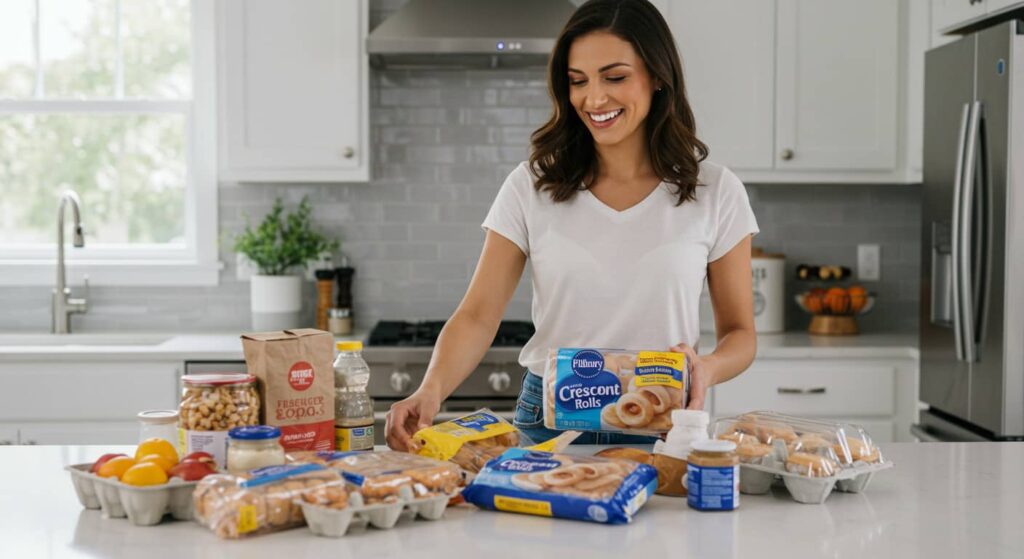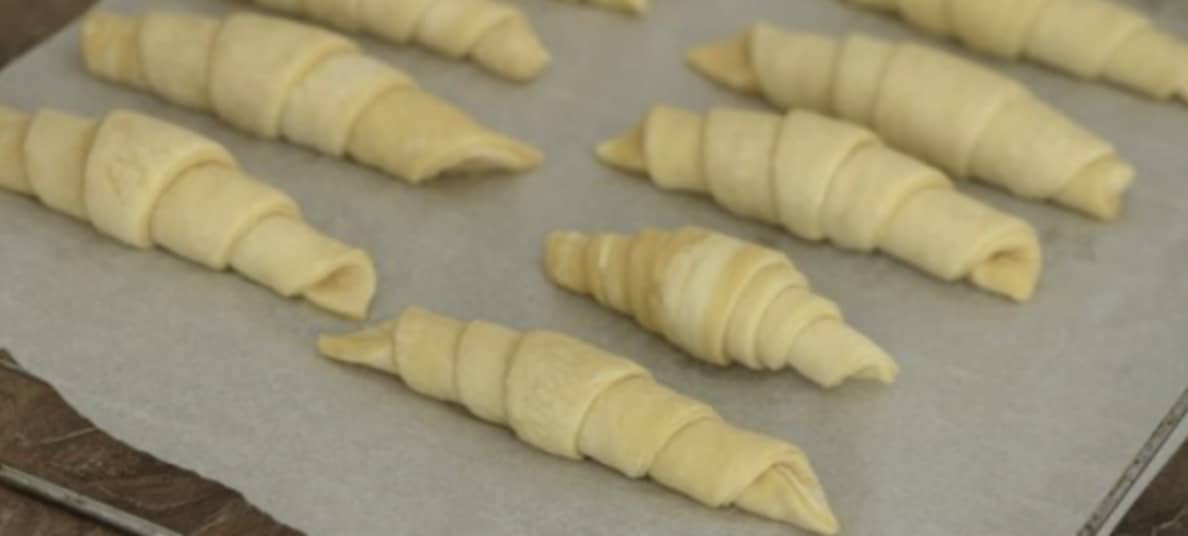Crescent rolls are a quick and easy treat. Whether you serve them for breakfast, dinner, or a holiday feast, they’re always a crowd-pleaser. However, they don’t always turn out fluffy and perfect. If you’ve struggled to get your Pillsbury crescent rolls to rise, you’re not alone!
The good news? It’s not as complicated as it sounds. Most rising issues happen because of temperature, handling, or baking mistakes. Fixing these small details can make a big difference. Let’s dig into why crescent rolls might not rise and what you can do about it!
Table of contents
“A little patience and the right baking tricks can transform flat rolls into soft, fluffy perfection.”
Understanding Pillsbury Crescent Rolls

Before we tackle the fixes, it’s helpful to understand what Pillsbury crescent rolls are and how they work.
What Are Pillsbury Crescent Rolls?
Pillsbury crescent rolls are pre-made dough in a canister. They’re convenient, fast, and require minimal prep. All you have to do is pop the can, unroll the dough, and bake. Easy, right? But there’s one catch: you still need to handle the dough correctly for it to rise properly.
The rolls contain a leavening agent—similar to baking powder—that helps them puff up when baked. The dough also has fats (like butter or oil) that create layers and give the rolls their flaky texture. When baked at the right temperature, steam from the dough lifts those layers, and the rolls rise beautifully.
Why Pillsbury Crescent Rolls Don’t Always Rise
So, why do crescent rolls sometimes flop? Here are a few reasons:
- The Dough Is Too Cold
Crescent roll dough needs to be close to room temperature before baking. If it’s too cold, the leavening agent won’t activate fully. - The Oven Isn’t Hot Enough
A properly preheated oven is key! If the oven temperature is off, the rolls won’t rise as they should. - The Dough Was Over-handled
Stretching, pressing, or kneading the dough too much can deflate it. Crescent rolls are delicate—handle them gently. - Old or Expired Dough
Check the expiration date on your can. Dough that’s past its prime won’t rise well because the leavening agents weaken over time.
Knowing these common mistakes will help you avoid them and get that perfect rise.
Key Ingredients and Their Role in Rising

Every ingredient in crescent roll dough plays a specific role. Understanding these roles will help you get the most out of your dough.
The Importance of Yeast and Leavening Agents
Yeast is usually responsible for dough rising in homemade recipes. Pillsbury crescent rolls, however, use chemical leavening agents like baking powder and baking soda. When heated, these ingredients produce carbon dioxide gas, which puffs up the dough.
The key? Ensuring the leavening agents activate properly. This means baking at the correct temperature and avoiding cold dough.
How Temperature Affects Dough Rise
Temperature is everything when it comes to crescent rolls. Here’s why:
- Cold Dough: Cold dough slows down the leavening process. Letting the dough warm up slightly before baking gives the agents time to do their magic.
- Hot Oven: Crescent rolls need a quick burst of heat to puff up. If your oven isn’t preheated, the dough will rise unevenly or not at all.
“Temperature can make or break your crescent rolls. Treat it like Goldilocks—just right is perfect!”
The Role of Proper Kneading and Resting
While homemade dough requires kneading, Pillsbury crescent rolls don’t need much handling. In fact, less is more! Gently unroll and shape the dough to avoid pressing out air. If you have time, let the shaped rolls rest for a few minutes before baking. This can help them rise better.
Common Problems That Prevent Crescent Rolls From Rising
Let’s break down the top problems and how you can fix them.
1: Dough Was Too Cold
- Why It Happens: Straight from the fridge, the dough is too firm and won’t rise properly.
- How to Fix It: Let the dough sit out at room temperature for 10-15 minutes before unrolling it. This gives the leavening agents time to warm up.
2: Incorrect Baking Temperature
- Why It Happens: If the oven isn’t hot enough, the dough won’t rise evenly.
- How to Fix It: Always preheat your oven to 375°F (190°C) before baking. Use an oven thermometer to double-check the temperature.
3: Overworked or Underworked Dough
- Why It Happens: Pressing or stretching the dough too much pushes out air pockets, making it dense.
- How to Fix It: Handle the dough as little as possible. Gently unroll, shape, and place it on the baking sheet.
Problem 4: Expired or Improper Dough Storage
- Why It Happens: Old dough loses its leavening power, and poor storage can dry it out.
- How to Fix It: Check the expiration date on the can before baking. Always store unopened dough in the fridge.
How to Prepare Pillsbury Crescent Rolls for the Perfect Rise

Getting your crescent rolls to rise starts before they even go in the oven. Follow these simple steps to set yourself up for success every time.
Step 1: Check Expiration Dates and Storage Conditions
First things first: make sure your dough is fresh! Pillsbury crescent roll dough contains leavening agents that weaken over time. If the can is expired, the rolls won’t rise properly—no matter how well you bake them.
Pro Tip: Store unopened cans of dough in the fridge at all times. If the can feels soft or dented, it’s best to toss it and grab a fresh one.
Step 2: Let the Dough Come to Room Temperature
This is one of the biggest secrets to getting a good rise. Crescent roll dough straight from the fridge is too cold, which can stop the leavening agents from working their magic.
Here’s what to do:
- Remove the dough from the fridge and let it sit at room temperature for 10-15 minutes.
- Don’t let it sit too long—over-warmed dough can become sticky and hard to handle.
Letting the dough warm up a bit ensures that it rises better once it hits the oven. Think of it like warming up before a workout!
Step 3: Properly Unroll and Shape the Dough
When you unroll the crescent dough, do it gently. Pillsbury crescent rolls are delicate, and too much handling can flatten the dough. Here’s how:
- Pop the Can Carefully: Press the seam until the can pops open. Avoid squeezing or squishing the dough inside.
- Unroll the Dough Slowly: Lay the dough flat on a clean surface without pressing it down.
- Separate the Triangles: Use the perforated lines to gently tear apart each triangle. Don’t stretch them out!
Shaping Tip: When rolling the dough into crescents, start from the wide end and roll toward the narrow tip. Try not to press down or flatten the dough as you go. The looser the roll, the more room there is for the dough to rise.
Step 4: Allow the Dough to Rest Before Baking
After shaping your crescent rolls, let them rest for a few minutes before popping them into the oven. A quick 5-10 minute rest helps the dough relax, which can improve the rise.
Why does this work? Resting gives the leavening agents time to activate and allows any tension in the dough to ease. It’s like giving the rolls a little nap before the big show. 😴
“Good things take time, and crescent rolls are no exception. A short rest can make a big difference!”
Baking Tips to Get the Best Rise in Crescent Rolls

Baking isn’t just about following directions—it’s about getting the details right. Here are a few foolproof tips to ensure your crescent rolls bake up fluffy and golden every time.
Preheat Your Oven: Why It Matters
Never, and I mean never, skip preheating your oven! Pillsbury crescent rolls rely on a quick burst of heat to puff up and rise. If the oven isn’t fully preheated, the rolls will cook unevenly and turn out flat.
Here’s how to do it right:
- Preheat your oven to 375°F (190°C).
- Use an oven thermometer to ensure the temperature is accurate. Many ovens run hotter or cooler than you might think.
Why is this so important? When the dough hits the hot oven, the leavening agents release gas, which lifts the rolls. A cold oven won’t activate this process properly.
Use the Right Baking Sheet and Position in the Oven
The type of baking sheet you use matters more than you might realize. For the best results:
- Use a nonstick baking sheet or line it with parchment paper. This prevents sticking and helps the rolls bake evenly.
- Space the crescent rolls at least 2 inches apart. This gives them room to expand as they bake.
Where you place the baking sheet in the oven is also key:
- Place it in the center rack of the oven. This ensures even heat distribution and prevents the tops or bottoms from cooking too fast.
Adjusting Baking Time for Perfect Results
Most crescent roll packages recommend baking for 9-12 minutes, but oven times can vary. Keep an eye on your rolls!
- Look for a golden-brown color on the tops and edges.
- If the rolls are browning too quickly, loosely cover them with foil to prevent burning.
Quick Tip: Resist the urge to open the oven door too often. Each time you open it, the temperature drops, and that can mess with the rise.
Quick Fixes if Your Crescent Rolls Don’t Rise
Did your rolls still come out flat? Don’t panic—here are a few quick fixes you can try next time.
The Warm Oven Trick
If your dough seems sluggish and isn’t rising as expected, try the warm oven trick. Here’s how:
- Preheat your oven to 200°F (93°C) and then turn it off.
- Place the shaped crescent rolls on a baking sheet inside the warm (but turned off) oven.
- Let them rest for about 10-15 minutes before baking.
The gentle warmth helps activate the leavening agents and gives the dough a head start.
Adding Extra Steam to Your Oven
Steam can work wonders for crescent rolls. It helps create a softer crust and encourages a better rise. Here’s what to do:
- Place a heat-safe pan filled with a cup of water on the bottom rack of the oven.
- Preheat the oven as usual. The steam will build up as the oven heats.
- Bake the crescent rolls on the middle rack above the pan.
This trick mimics the steam method used in professional bakeries!
Reheating and Softening Flat Crescent Rolls
If your rolls came out flat and dense, you can still improve their texture slightly. Try reheating them:
- Wrap the rolls in a damp paper towel and microwave for 10-15 seconds.
- Alternatively, place them in a 300°F (150°C) oven for a few minutes to warm them up.
While this won’t make them rise, it can soften the rolls and make them taste fresher.
Enhancing the Flavor and Texture of Pillsbury Crescent Rolls
Once you’ve mastered getting your crescent rolls to rise, why not take things up a notch? Here are a few easy ways to add more flavor and improve the texture of your crescent rolls.
Brushing the Rolls With Butter or Egg Wash
Want crescent rolls that look and taste straight out of a bakery? The secret is a quick brush before baking.
- Butter Brush: Melted butter brushed on the rolls adds a rich, savory flavor and a beautiful golden-brown shine.
- Egg Wash: Mix one egg with a tablespoon of water and brush it lightly on the rolls. This creates a glossy, professional-looking finish.
Pro Tip: Add a sprinkle of garlic powder, sesame seeds, or a little parmesan cheese after brushing to add a tasty twist!
Adding Fillings That Complement Crescent Rolls
Pillsbury crescent rolls are like a blank canvas—they’re perfect for experimenting with different fillings. Here are a few ideas to inspire you:
- Savory Fillings: Add a slice of cheddar cheese, ham, or pepperoni before rolling up the dough. The fillings bake perfectly inside for a delicious snack.
- Sweet Fillings: Spread a thin layer of cream cheese, Nutella, or jam on the dough before rolling. Dust with powdered sugar after baking for a sweet treat!
- Herb Butter: Mix melted butter with parsley, garlic, and a pinch of salt. Brush this mixture on the rolls right out of the oven.
Whether sweet or savory, adding fillings takes crescent rolls to a whole new level! 🤤
Frequently Asked Questions (FAQs)
Let’s tackle some of the most common questions people have about Pillsbury crescent rolls and their rise.
Why Do My Crescent Rolls Turn Out Flat?
Crescent rolls turn out flat for a few reasons:
- The dough was too cold when baked.
- The oven wasn’t preheated to the right temperature.
- The rolls were over-handled, which flattened the dough.
To fix this, let the dough rest at room temperature before baking and handle it gently.
Can I Proof Pillsbury Crescent Rolls Like Homemade Dough?
Not really! Pillsbury crescent rolls use chemical leavening agents like baking powder instead of yeast, so they don’t require proofing like homemade dough. However, letting the shaped rolls rest for a few minutes before baking can help improve their rise.
What’s the Ideal Baking Temperature and Time?
The ideal baking temperature for Pillsbury crescent rolls is 375°F (190°C). Bake them for 9-12 minutes, keeping a close eye to avoid over-browning.
If your oven runs hotter or cooler, consider using an oven thermometer for accuracy.
Conclusion
Getting your Pillsbury crescent rolls to rise perfectly doesn’t have to be tricky. With the right temperature, gentle handling, and a few simple tricks, you’ll be serving up soft, fluffy, golden-brown crescents every time. Whether it’s letting the dough warm up, preheating your oven, or adding steam for an extra lift, small changes can make a big difference.
Remember: baking is all about patience and practice. Don’t get discouraged if your rolls don’t turn out perfect on the first try. Keep these tips in mind, and soon you’ll be a crescent roll pro!
“Perfect crescent rolls are just a few simple steps away. Warm, flaky, and delicious—your family will thank you!”
Final Tips for Perfectly Fluffy Pillsbury Crescent Rolls
Let’s wrap up with a few final tips:
- Always let the dough sit at room temperature for 10-15 minutes before baking.
- Preheat your oven and use the center rack for even baking.
- Handle the dough gently to avoid pressing out air pockets.
- Experiment with butter, egg wash, or tasty fillings to level up your crescent rolls.
With these tips in your baking toolbox, you’ll never have to worry about flat crescent rolls again. Enjoy the buttery goodness of fluffy, perfectly risen rolls every time! 🥐✨

